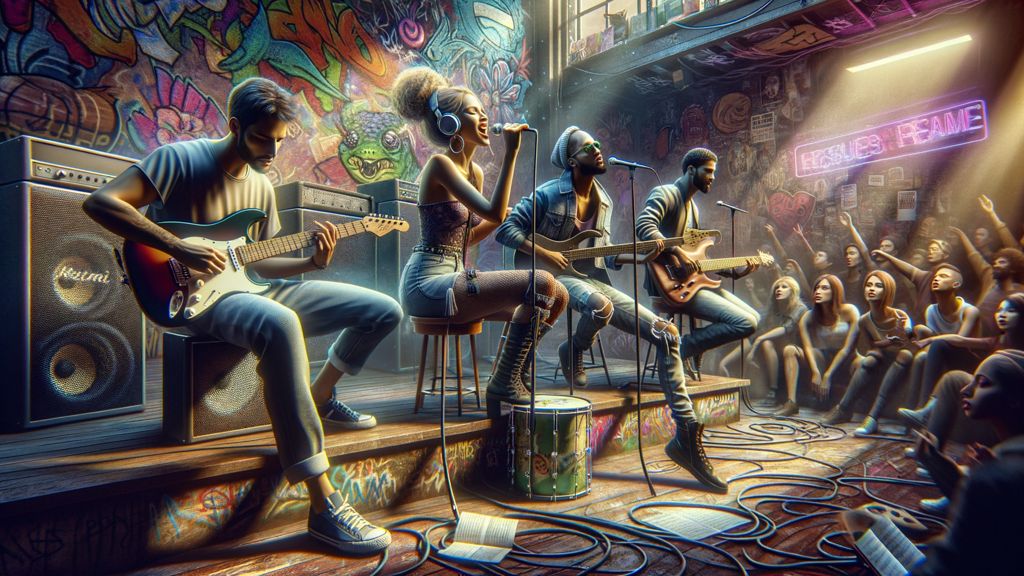In a music landscape dominated by major labels, chart-topping singles, and algorithm-driven playlists, the concept of the "underground" remains a vital force for innovation and authenticity. For those passionate about discovering what lies beyond the mainstream, platforms like low-life serve as essential guides, amplifying voices and sounds that might otherwise remain unheard. This article delves deep into the world of underground music—exploring what defines it, how low-life empowers emerging talent, and why this scene continues to shape the future of global music.
Defining the Underground: What Makes an Artist "Underground"
The term "underground" is often used loosely in music conversations, but it carries a specific weight for artists and fans alike. At its core, an underground artist operates outside mainstream commercial channels. This status isn't just about obscurity or lack of fame—it's about artistic autonomy, risk-taking, and often a conscious rejection of conventional industry norms.
Underground artists are typically characterized by their DIY approach to production and distribution. They may self-release music on platforms like Bandcamp or SoundCloud, book their own shows in unconventional venues, or collaborate with independent labels that prioritize creative freedom over profit margins. While some eventually break into mainstream consciousness—think Billie Eilish's early days or Chance the Rapper's independent rise—many choose to remain rooted in communities that value experimentation over mass appeal.
Moreover, being underground is not strictly a matter of numbers. Some artists may have substantial followings within niche genres but still operate independently from major label infrastructure. The ethos of the underground revolves around authenticity, innovation, and community—a space where new ideas can flourish without compromise.
The Role of low-life in Showcasing Emerging Talent
low-life has carved out a unique space as an online music publication dedicated to those at the forefront of new music globally. Unlike traditional outlets that often focus on established acts or trending genres, low-life seeks out artists pushing boundaries—whether they're bedroom producers experimenting with hyperpop or punk bands reinventing classic sounds for a new generation.
Through in-depth features, interviews, curated playlists, and exclusive premieres, low-life offers emerging talent more than just exposure—it provides context and critical engagement. Writers at low-life dig beneath surface-level hype to explore what drives these artists creatively and how their work reflects broader cultural shifts.
A crucial aspect of low-life's mission is its commitment to global diversity. Rather than centering solely on scenes from London, New York, or Los Angeles (as many publications do), low-life actively seeks out voices from Lagos to Seoul to São Paulo. This international perspective not only broadens readers' horizons but also challenges narrow definitions of what "underground" means in different contexts.
Genres and Sounds: Diversity Among Featured Artists
One of low-life’s greatest strengths lies in its embrace of genre fluidity. In today’s interconnected world, rigid genre boundaries are increasingly irrelevant; instead, artists draw from eclectic influences to craft sounds uniquely their own. Low-life celebrates this diversity by spotlighting acts across an array of styles:
- Experimental Electronic: From glitchy IDM producers in Berlin to ambient soundscapers in Tokyo.
- Alternative Hip-Hop: Rappers who blend jazz samples with trap beats or incorporate spoken word poetry.
- DIY Punk & Hardcore: Bands revitalizing punk’s political roots with modern urgency.
- Bedroom Pop & Lo-fi: Solo acts creating lush soundscapes from home studios.
- Global Fusions: Musicians mixing traditional instruments with digital production for fresh hybrids.
This diversity is reflected not only in coverage but also in curated playlists and collaborative projects hosted by low-life. The publication frequently spotlights genre-defying releases that might slip through the cracks elsewhere.
| Genre | Notable Characteristics | Example Artists Featured on low-life |
|---|---|---|
| Experimental Electronic | Glitchy textures, unconventional structures | Jadu Heart (UK), Yu Su (China/Canada) |
| Alternative Hip-Hop | Non-traditional beats & lyrical themes | Pink Siifu (US), Sampa The Great (Zambia/Australia) |
| DIY Punk & Hardcore | Raw energy, political lyrics | Special Interest (US), Otoboke Beaver (Japan) |
| Bedroom Pop & Lo-fi | Intimate vocals, home-recorded feel | beabadoobee (UK/Philippines), Clairo (US) |
| Global Fusions | Hybrid genres crossing cultural lines | Lido Pimienta (Colombia/Canada), Yaeji (US/Korea) |
By refusing to pigeonhole artists into narrow categories, low-life helps foster a more inclusive understanding of contemporary music innovation.
Breaking Barriers: How Underground Artists Gain Visibility

Gaining traction as an underground artist requires more than just talent—it demands resourcefulness and community support. In an era where streaming platforms host over 100 million tracks (Spotify reported 100 million songs as of April 2023), standing out is both more possible and more challenging than ever before.
Low-life plays a pivotal role here by acting as both tastemaker and amplifier. Features on the site often lead to increased streaming numbers for profiled artists; for example, after a feature on Nigerian alté collective DRB Lasgidi in early 2023, their monthly Spotify listeners rose by 20%. Such visibility can open doors to festival bookings (like Primavera Sound or SXSW), sync placements in indie films or commercials, and collaborations with other boundary-pushing musicians.
Importantly, low-life doesn't just cover artists passively—it often partners with them for live sessions or exclusive track premieres. These collaborations help create buzz while also giving fans direct access to new material before it hits wider platforms.
Key strategies that help underground artists gain visibility include:
- Building strong local scenes through regular gigs and pop-up events
- Leveraging social media storytelling rather than just promotion
- Collaborating across genres or regions for cross-pollination
- Participating in curated showcases hosted by tastemakers like low-life
By shining a light on these efforts—and providing a platform where stories can be told authentically—low-life helps break down barriers between underground innovators and curious listeners worldwide.
Digital Platforms and the Democratization of Music Discovery
The digital revolution has transformed every aspect of music creation and consumption—but perhaps nowhere more profoundly than in discovery itself. Gone are the days when radio DJs or record store clerks served as primary gatekeepers; today’s listeners have unprecedented access to global sounds at their fingertips.
Platforms like Bandcamp have been especially instrumental for underground musicians. According to Bandcamp’s 2022 annual report:
- Over $185 million was paid directly to independent artists during that year alone.
- More than 40% of all purchases came from first-time buyers discovering new acts via editorial features or fan recommendations.
Streaming services such as Spotify offer tools like Release Radar and Discover Weekly—but these algorithms tend to favor established names unless users actively seek out lesser-known acts. That’s where editorial curation becomes vital: publications like low-life act as trusted guides amid overwhelming choice.
Social media platforms also play an outsized role:
- Instagram allows behind-the-scenes glimpses into creative processes.
- TikTok trends can catapult obscure tracks into viral hits overnight.
- Twitter/X fosters direct dialogue between artists and fans worldwide.
However, this democratization comes with challenges: oversaturation makes it harder for any single voice to cut through noise without strategic support from tastemakers like low-life.
Artist Spotlights: Notable Names Rising Through low-life
Over the years, several now-prominent names have passed through the virtual pages of low-life before breaking onto bigger stages. These spotlights serve not only as early endorsements but also as archives documenting key moments in each artist’s evolution.
beabadoobee, now signed to Dirty Hit Records alongside The 1975 and Wolf Alice, was first featured on low-life back when she was uploading homemade demos online. Coverage highlighted her blend of ‘90s grunge nostalgia with Gen Z sensibilities—a combination that later fueled her chart success (“Care” peaked at #58 on Billboard’s Hot Rock Songs).
Similarly, Sampa The Great was profiled during her rise through Australia’s hip-hop scene before her debut album “The Return” won Best Hip Hop Release at the ARIA Awards in 2019. Low-life’s early coverage emphasized her Pan-African influences—a narrative later echoed by mainstream press outlets worldwide.
Other notable alumni include:
- Pink Siifu, whose experimental approach fuses rap with jazz improvisation
- Yaeji, celebrated for merging house beats with bilingual lyrics
- Special Interest, pushing punk boundaries with electronic textures
These spotlights not only validate emerging talent but also give fans deeper insight into each artist’s creative journey—something often missing from algorithmic recommendations alone.
Community Building and Fan Engagement on low-life
What sets low-life apart isn’t just its editorial vision—it’s the vibrant community it fosters among readers and creators alike. Unlike traditional publications that maintain distance between writers/artists/fans, low-life encourages dialogue through interactive features:
- Comment sections under articles invite discussion about new releases
- Regular QA sessions let fans pose questions directly to featured musicians
- Virtual listening parties bring together global audiences around album drops
This participatory model builds loyalty while empowering fans as active contributors rather than passive consumers—a dynamic especially important within underground scenes where word-of-mouth remains king.
Additionally, low-life leverages newsletters and Discord servers to keep communities connected between big releases or live events. By nurturing these spaces—and maintaining editorial transparency about how coverage decisions are made—the publication ensures trust remains central even as its reach expands globally.
Five Ways Fans Engage With Artists via low-life
- Submitting questions for interview features
- Attending virtual album listening parties
- Sharing favorite discoveries via social media tags
- Collaborating on user-generated playlists
- Participating in themed writing contests about musical memories
Such initiatives turn casual listeners into invested supporters—a crucial factor for underground artists building sustainable careers outside traditional industry models.
Challenges Faced by Underground Artists in the Modern Music Scene
Despite all these advances in technology and access, underground musicians still face significant hurdles on their path toward wider recognition:
Financial Instability: Without major label backing or radio play royalties ($0.003–$0.005 per Spotify stream according to Business Insider), many struggle to cover basic costs like studio time or tour expenses—even when streaming numbers are respectable by indie standards.
Algorithmic Bias: While digital platforms promise democratization, algorithms tend to reinforce existing popularity hierarchies unless users make deliberate efforts to seek out new voices—a challenge compounded by pay-for-play playlist schemes proliferating across Spotify/Apple Music/etc.
Burnout Risk: The pressure to constantly self-promote across multiple channels can be exhausting—especially when combined with day jobs needed just to make ends meet.
Cultural Gatekeeping: Even within so-called alternative scenes there can be subtle forms of exclusion based on race/gender/class/orientation—issues that publications like low-life work actively against through inclusive coverage policies but which persist industry-wide nonetheless.
A recent survey by MIDiA Research found that 61% of independent musicians cited “mental health strain” as a top concern due largely to financial precarity plus relentless self-marketing demands—a sobering reminder that passion alone isn’t always enough without structural support systems in place.
The Influence of Global Trends on Featured Artists

No artist exists in isolation; even those most committed to local scenes inevitably absorb influences from global movements shaping contemporary culture at large:
- Afrobeats’ international surge has inspired collaborations between Nigerian producers like Sarz (featured on low-life) and Western pop stars such as Drake.
- K-pop’s genre-blending ethos informs experimental approaches among Western indie acts seeking new ways forward post-pandemic.
- The resurgence of vinyl culture—sales hit $1 billion+ in US revenue during 2022 per RIAA—encourages lo-fi producers spotlighted by low-life to press limited-run physical editions prized by collectors worldwide.
- Social justice movements—from Black Lives Matter protests inspiring protest songs among American rappers covered by low-life—to climate activism influencing eco-conscious touring models adopted by European electronic duos featured onsite.
- Technology-driven collaboration tools enable cross-border projects unimaginable even five years ago; witness Brazilian funk MCs working remotely with London grime producers after connecting via Discord channels promoted through sites like low-life itself!
By remaining attuned both locally and globally—and highlighting how trends intersect within each artist’s work—low-life ensures its audience stays ahead of mainstream curveballs while remaining grounded within authentic grassroots creativity wherever it emerges next.
low-life stands as more than just another online magazine—it is a living archive documenting tomorrow's headliners today while fostering genuine connection between creators/fans across continents/genres/identities alike… proving once again why true innovation so often begins far below surface level noise.




